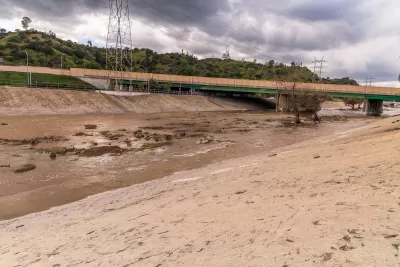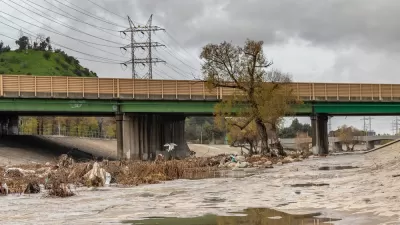During this “super year” of storms, L.A. County has successfully captured 96 billion gallons of stormwater which is enough to meet the needs of about 2.4 million people a year.

Los Angeles County has managed to capture and store a significant amount of stormwater brought forth by heavy rains this winter and spring which sent torrential flows down local creeks and rivers. Specifically, an estimated 295,000 acre-feet of water since last October or 96.3 billion gallons was captured. This is sufficient to meet the water needs of approximately 2.4 million people a year, which is almost one-fourth of the county’s population of ten million residents.
As reported by Ian James, the county, working in coordination and collaboration with the Los Angeles Department of Water and Power and other agencies, was able to capture and store this amount of water thanks in part to investments totaling over $1 billion since 2001. Some of the funding has been used to raise dams and increase the capacity of spreading grounds, where water is sent into basins and then percolates underground into aquifers.
The county has also spent more than $1 billion since 2001 to remove sediment from reservoirs to ensure their water-catching capacity is not limited or diminished. A large portion of the funds have come from the L.A. County Flood Control District, which receives revenues through property taxes. Funding for stormwater-catching infrastructure is also generated through the Safe, Clean Water Program, which was established after county voters passed Measure W in 2018.
Though the amount of runoff captured since October has been substantial, the county’s facilities took in more water during the major storms over the previous 12 months — an estimated 626,000 acre-feet, which is enough to supply about five million residents for a year.
To learn more, please read the source article.
FULL STORY: L.A. County captures 96 billion gallons of water during ‘super year’ of storms

Maui's Vacation Rental Debate Turns Ugly
Verbal attacks, misinformation campaigns and fistfights plague a high-stakes debate to convert thousands of vacation rentals into long-term housing.

Planetizen Federal Action Tracker
A weekly monitor of how Trump’s orders and actions are impacting planners and planning in America.

San Francisco Suspends Traffic Calming Amidst Record Deaths
Citing “a challenging fiscal landscape,” the city will cease the program on the heels of 42 traffic deaths, including 24 pedestrians.

Adaptive Reuse Will Create Housing in a Suburban Texas Strip Mall
A developer is reimagining a strip mall property as a mixed-use complex with housing and retail.

Study: Anti-Homelessness Laws Don’t Work
Research shows that punitive measures that criminalized unhoused people don’t help reduce homelessness.

In U.S., Urban Gondolas Face Uphill Battle
Cities in Latin America and Europe have embraced aerial transitways — AKA gondolas — as sustainable, convenient urban transport, especially in tricky geographies. American cities have yet to catch up.
Urban Design for Planners 1: Software Tools
This six-course series explores essential urban design concepts using open source software and equips planners with the tools they need to participate fully in the urban design process.
Planning for Universal Design
Learn the tools for implementing Universal Design in planning regulations.
Heyer Gruel & Associates PA
JM Goldson LLC
Custer County Colorado
City of Camden Redevelopment Agency
City of Astoria
Transportation Research & Education Center (TREC) at Portland State University
Jefferson Parish Government
Camden Redevelopment Agency
City of Claremont





























